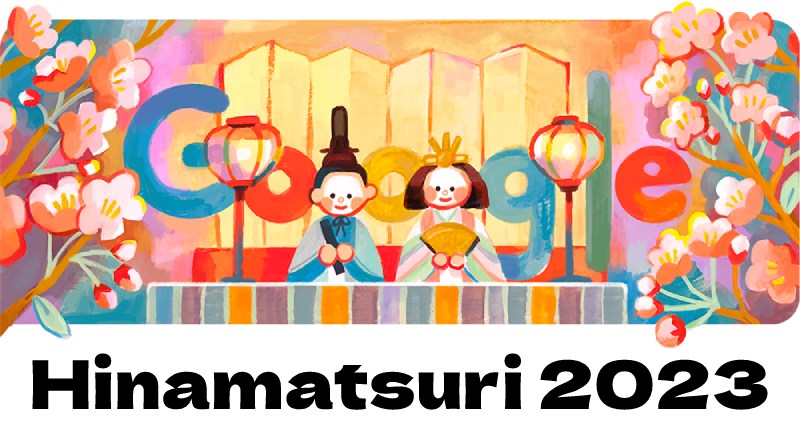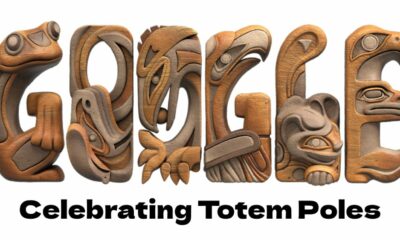Festivals & Events
Amazing Fun Facts about Hinamatsuri, a Japanese Doll Festival or Girls’ Day in Japan

Google Doodle celebrates Hinamatsuri (雛祭り), also known as the Japanese Doll Festival or Girls’ Day, a religious (Shinto) holiday in Japan, on March 3, 2023. Hinamatsuri-related trivia can be found in the following list.
40 Interesting and Amazing Fun Facts about Hinamatsuri
- In Japan, March 3 is celebrated as “Girls’ Day” with the “Hina Matsuri” (Doll Festival or Girls’ Festival). Since the Edo Period (1603-1868), beautiful Hina dolls have been displayed in homes and public areas on this day.
- Parents pray for their daughters’ good health and happiness during Hina Matsuri, a celebration dedicated to girls.
- This day marks the beginning of the peach blossom season. The celebration is also known as Momo no Sekku, which means “peach blossom festival.”
- March 3 is a special day for girls, though it is not a national holiday. It’s possible that families without young daughters won’t do anything extra special for the holiday.
- However, this festival is associated with numerous customs. In fact, celebrations of Hina Matsuri vary greatly from region to region.
- A set of ornamental dolls (雛人形, hina-ningyō) representing the Emperor, Empress, attendants, and musicians in traditional Heian period court attire are displayed on platforms covered in red carpet material.
- One of the five seasonal festivals (五節句, gosekku) on auspicious dates in the Chinese calendar is Hinamatsuri: the first day of the first month, the third day of the third month, and so on.
- These dates were established on January 1, March 3, May 5, July 7, and September 9 following the adoption of the Gregorian calendar.
- Because peach trees typically begin to bloom around this time, the festival was traditionally known as the Peach Festival (桃の節句, Momo no Sekku). Even though this is no longer the case since the adoption of Gregorian dates, the name has not changed, and peaches are still used as a symbol of the festival.
- To commemorate the health and happiness of girls all over the world, some families put up a display of Hina dolls in their homes. It is said that Hina Dolls will protect children from harm and keep diseases and accidents at bay.
- The ancient Japanese belief that dolls could carry bad luck and filth by being thrown into rivers gave rise to this custom. Around the Edo Period (1603-1868), when people began to celebrate it by temporarily displaying Hina dolls on stands, this was adapted into the festival.
- The imperial family is represented by Hina dolls. The emperor and the empress are represented by the dolls at the top of the platforms. The remaining dolls include five musicians, three court ladies, and ministers from the right and left who previously supported the government.
- Along with the dolls, there are oxcarts, small cupboards, Japanese paper lamps called “bonbori,” and branches from orange and peach trees.
- In addition, each doll has distinct costumes and facial expressions based on its personality and position.
- Unless the parents or grandparents have special dolls that have been passed down through the generations, it is customary for them to purchase a set of Hina dolls for the newborn girl.
- On red carpet-covered platforms on tiers, hina dolls in traditional Japanese costumes are displayed from the end of February to March 3.
- The emperor, empress, attendants, and musicians are portrayed by the costumed dolls, who are a representation of the imperial court during the Heian period (A.D. 794 to 1185).
- The emperor and empress are at the top of the hierarchy of the dolls, which are displayed in front of a gilded screen depicting the throne. Depending on the house, there may be anywhere from five to seven doll platforms.
- There is a superstition that if the dolls are left out, a family will have trouble marrying off its daughters. As soon as the festival is over, it is customary to put the dolls away. Some people, following the festival, toss paper dolls into the rivers in the hope that this will ward off sickness and bad luck.
- The main tradition of the Hina Matsuri doll festival is to mount an altar covered with a dankake, or red carpet, on which several platforms of hina-ningyō, or ornamental dolls, dressed in Heian period court dress, are placed.
- Due to their high cost—between $1,500 and $2,500 for a 5-tier set—hina dolls are typically passed down through the family. On the other hand, whenever a baby girl in the family is born, her grandparents frequently present her with hina sets.
- Since a separate day, historically called “Boys’ Day” but now known as “Children’s Day,” is celebrated on May 5 during Golden week in Japan, boys typically do not participate in Hinamatsuri.
- Every year, Hina Matsuri is celebrated on March 3rd. It is one of Japan’s five seasonal festivals, or sekku, that have traditionally and historically been celebrated on good days on the Chinese calendar.
- The other seasonal festivals remember New Year on January 1st, Tango no sekku on May 5th, the Tanabata Matsuri festival on July 7th, and Kikku no sekku on September 9th.
- Hinamatsuri was traditionally known as Momo no Sekku, which translates to “the peach festival.” This was because Hinamatsuri was traditionally held after winter when the peach trees in Japan started to flower. Since Japan has switched to the Gregorian calendar, this is no longer the case, but the name is still popular today.
- Hina-ningyō altars are typically erected by families in mid-February; however, it is important to remove them after Hina Matsuri.
- In theory, this is done to avoid the humidity of the rainy season in March, which could harm the dolls. However, old customs say that if the altar is left up after the date, the family’s daughters will have trouble marrying.
- The origin of the festival dates back more than 1,000 years to the Heian era in Japan when special dishes and ceremonies were held to mark the March sekku.
- This is when the modern practices of Hina Matsui began when simple paper dolls called hitogata began to be made.
- The fact that these dolls were historically used as charms to ward off evil spirits is one of Hinamatsuri’s most interesting facts. The custom was to float a paper hitogata doll down a river that led to the sea in the hope that they would bring with them dangers of illness and bad luck.
- Due to the influence of hina-asobi, a type of Japanese doll play, the tradition and custom of displaying dolls on an altar in typical Japanese households did not begin until the Edo period. Hinamatsuri gradually came to be associated with celebrating the growth and health of young girls over time.
- A Hinamatsuri altar’s dolls depict the Emperor, Empress, attendants, and musicians who would have been present at a royal court during this period. They are dressed in Heian period court dress.
- The accepted positioning of the altar’s five to seven tiers is as follows:
- Platform 1 is reserved for the Emperor and Empress dolls, flanked by a miniature gilded folding screen.
- Platform 2 is reserved for the san-nin kanjo, three ladies-in-waiting who serve drinks to the male and female dolls.
- Platform 3 is reserved for the go-nin bayashi, court musicians who each hold a different instrument.
- Platform 4 is the designated tier for dolls representing the court ministers or bodyguards, as well as objects representing gifts for the imperial couple.
- Platform 5 is the reserved tier for dolls representing the palace guards, who are flanked by a miniature mandarin orange tree to the left and a sakura cherry tree to the right.
- If there is a sixth or seventh tier, this platform usually shows household things like furniture, mirrors, and Ox-drawn carts that were common in the home at the time. On these tiers, miniature kitchens and cooking utensils are typically displayed on altars made in Kyoto, whereas altars made in Tokyo typically have many more steps that display a variety of extravagant furnishings.
- In addition to decorating a doll altar with peach blossom sprigs, Hinamatsuri is typically observed in the days leading up to March 3 by hosting parties for children.
- It has established itself as a festival renowned for its exciting selection of traditional dishes, which include:
- Hina-arare is sugary, pastel-colored rice crackers that are only available during the Hina Matsuri season.
- Chirashi-zushi is sushi that has been slightly sweetened and is served with clam soup.
- Hishi-mochi is rice cakes in the shape of a rhomboid that is traditionally fertility symbolic. They come in 3 colors – white to represent snow, pinkish-red to represent peach blossoms or green to represent the upcoming spring.
- Amazake, a non-alcoholic sake, is typically served during Hinamatsuri, reflecting the festival’s emphasis on family.
- The Katsuura Big Hina Matsuri festival, which is held in the small seaside town of Katsuura in Chiba Prefecture from late February to early March, is Japan’s most well-known Girl’s Day celebration.
- During this time, approximately 30,000 dolls are displayed throughout the town, and various stalls offer the traditional sweets associated with Hinamatsuri.
- If you are in Tokyo during this time, you can also visit the Meguro Gajoen building’s famous Hundred-Steps Staircase, which is completely covered in old Hinamatsuri dolls from across the region of Kyushu.
- Finally, during Hina Matsuri, the ancient tradition, and custom of floating paper dolls down a river is still practiced in many parts of Japan, particularly at the Edo Nagashi Bina Festival in the Asakusa district of Tokyo.
-

 Sports4 weeks ago
Sports4 weeks agoFIFA Club World Cup 2025: Complete List of Qualified Teams and Groups
-

 Sports2 weeks ago
Sports2 weeks agoAl Ahly vs Inter Miami, 2025 FIFA Club World Cup – Preview, Prediction, Predicted Lineups and How to Watch
-
Health1 week ago
Back to Roots: Ayurveda Offers Natural Cure for Common Hair Woes
-
World4 weeks ago
Omar Benjelloun: Strategic Architect Behind Major Financial Deals in the MENA Region
-

 Sports3 weeks ago
Sports3 weeks agoFIVB Men’s Volleyball Nations League 2025: Full Schedule, Fixtures, Format, Teams, Pools and How to Watch
-

 Tech1 week ago
Tech1 week agoFrom Soil to Silicon: The Rise of Agriculture AI and Drone Innovations in 2025
-

 Startup2 weeks ago
Startup2 weeks agoHow Instagram Is Driving Global Social Media Marketing Trends
-

 Science4 weeks ago
Science4 weeks agoEverything You Need to Know about Skywatching in June 2025: Full Moon, New Moon, Arietid Meteors, and Planetary Marvels

























